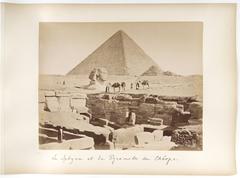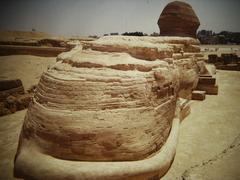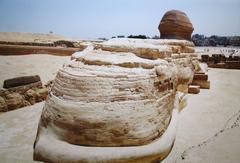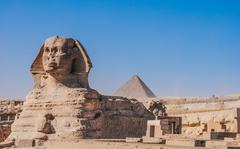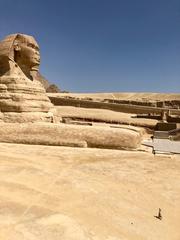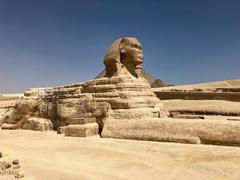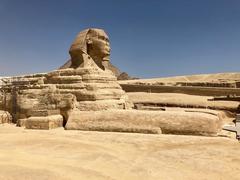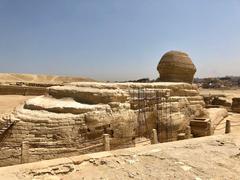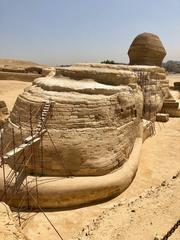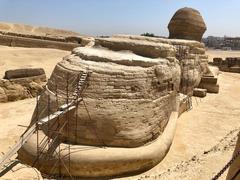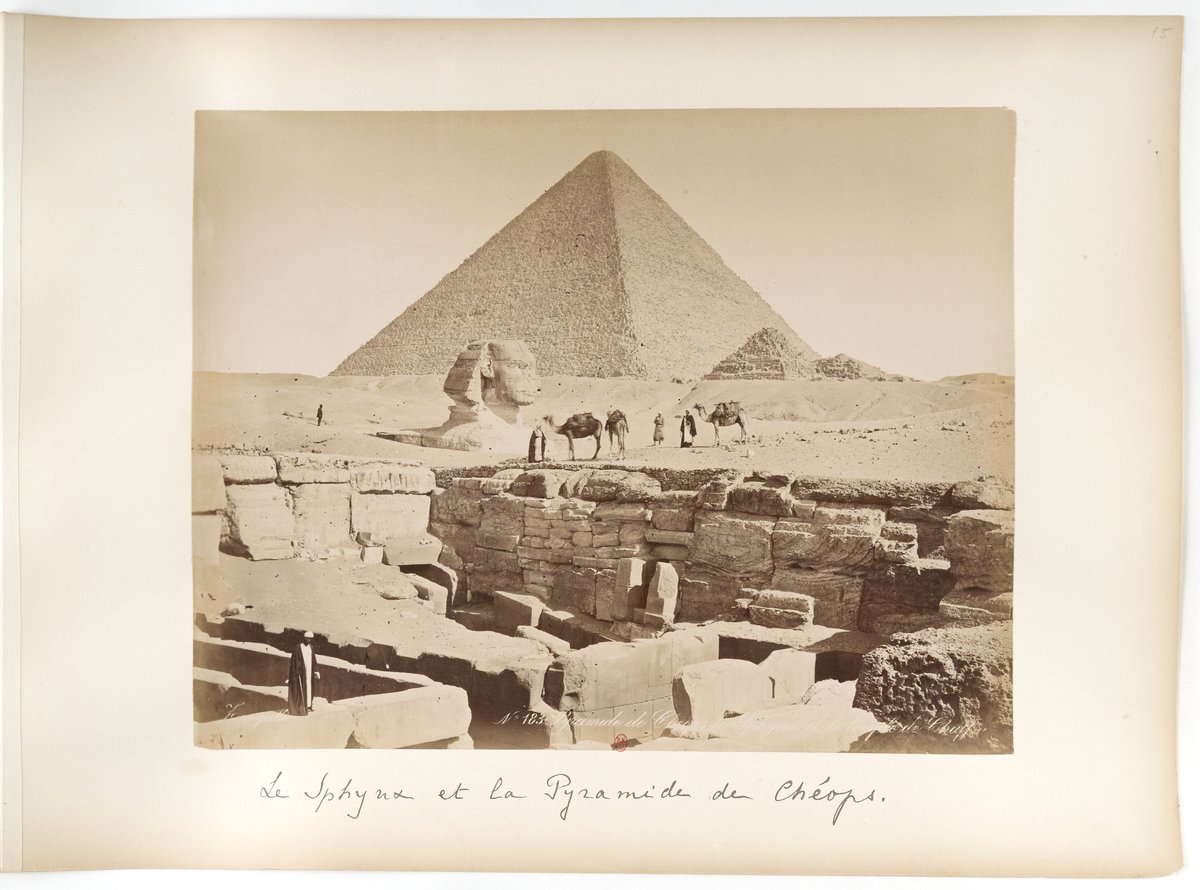
Sphinx Visiting Guide: Hours, Tickets, and History
Date: 17/07/2024
Introduction
The Great Sphinx of Giza is one of the world’s most iconic and enigmatic monuments, symbolizing the grandeur and mystery of ancient Egypt. It stands majestically on the Giza Plateau, adjacent to the Great Pyramids, and has captivated the imagination of scholars, tourists, and historians alike for millennia. Believed to have been constructed during the reign of Pharaoh Khafre around 2558–2532 BCE, the Sphinx is a colossal limestone statue with the body of a lion and the head of a human, thought to represent the pharaoh himself (Smithsonian Magazine). Measuring approximately 73 meters in length and 20 meters in height, it is the largest monolithic statue in the world, carved directly from the bedrock of the plateau.
The Sphinx holds profound cultural and religious significance, often interpreted as a symbol of royal power and protection. Its lion’s body represents strength and authority, while the human head signifies intelligence and wisdom. Throughout history, the Sphinx has undergone various periods of neglect and restoration, including a major project by Pharaoh Thutmose IV during the New Kingdom (National Geographic). Modern archaeological research and conservation efforts continue to provide new insights into its construction and condition, revealing unknown chambers and tunnels beneath the monument.
Visiting the Great Sphinx is a must for anyone traveling to Cairo, Egypt. This comprehensive guide will provide essential information on its history, ticket prices, visiting hours, travel tips, and nearby attractions, ensuring a memorable and informative visit.
Table of Contents
Historical Background
Origins and Construction
The Great Sphinx of Giza, believed to have been constructed during the reign of Pharaoh Khafre (c. 2558–2532 BCE) of the Old Kingdom’s Fourth Dynasty, is a limestone statue with the body of a lion and the head of a human, thought to represent Khafre himself. Situated on the Giza Plateau, adjacent to the Great Pyramids, the Sphinx is carved directly from the bedrock of the plateau. It measures approximately 73 meters (240 feet) in length and 20 meters (66 feet) in height, making it the largest monolithic statue in the world. The construction techniques used to create the Sphinx remain a subject of debate among historians and archaeologists.
Symbolism and Purpose
The Sphinx is often interpreted as a symbol of royal power and protection. The lion’s body represents strength and authority, while the human head signifies intelligence and wisdom. This combination of human and animal features symbolizes the divine nature of the pharaohs. The exact purpose of the Sphinx remains uncertain, with some scholars believing it served as a guardian of the Giza Plateau and others suggesting it was part of a larger complex dedicated to the sun god Ra.
Historical Significance
The Sphinx has played a significant role in Egyptian history and culture for millennia. Known in ancient times as “Hor-em-akhet,” meaning “Horus of the Horizon,” it was associated with the sky deity Horus. Throughout history, the Sphinx has undergone various periods of neglect and restoration, including a major restoration project by Pharaoh Thutmose IV during the New Kingdom (c. 1550–1070 BCE).
Modern Discoveries and Research
Recent archaeological research and conservation efforts have provided new insights into the monument’s construction and condition. Modern technology has revealed previously unknown chambers and tunnels beneath the Sphinx. One significant discovery is the identification of weathering patterns on the Sphinx’s body, which some researchers argue indicate that the monument is much older than previously thought.
Preservation Challenges
The Sphinx faces numerous preservation challenges due to its age and exposure to the elements. Wind, sand, and pollution have contributed to its gradual erosion, necessitating ongoing conservation efforts. The Egyptian government has implemented measures to control access to the Sphinx and its surrounding area to protect the site from environmental and human-induced threats.
Visiting Information
Ticket Prices
Tickets for visiting the Great Sphinx are typically included in the general admission to the Giza Plateau. Prices may vary, so it’s advisable to check the official website or contact local tour operators for the latest information.
Opening Hours
The Great Sphinx is open to visitors from 8:00 AM to 5:00 PM daily. During the summer months, hours may be extended. It is recommended to visit early in the morning or late in the afternoon to avoid the midday heat.
Travel Tips
- Best Time to Visit: The cooler months from October to April are ideal for visiting the Sphinx.
- Photography: The best time for photography is during sunrise or sunset when the lighting is optimal.
- Guided Tours: Consider booking a guided tour for a more informative experience.
- What to Bring: Bring water, sunscreen, and a hat to protect yourself from the sun.
- Dress Code: Wear comfortable clothing and shoes suitable for walking on uneven terrain.
Nearby Attractions
Great Pyramids of Giza
Located adjacent to the Sphinx, the Great Pyramids are a must-see. These include the Pyramid of Khufu (the Great Pyramid), the Pyramid of Khafre, and the Pyramid of Menkaure. These pyramids are among the most famous and well-preserved structures from ancient Egypt, offering a glimpse into the architectural prowess of the ancient Egyptians (UNESCO).
Solar Boat Museum
This museum houses the reconstructed Khufu solar boat, an ancient vessel that was buried near the pyramid to transport the pharaoh’s soul to the afterlife. The museum provides fascinating insights into ancient Egyptian shipbuilding techniques (Egyptian Ministry of Antiquities).
Cairo Museum
Located in downtown Cairo, the Cairo Museum offers extensive collections of ancient Egyptian artifacts, including the treasures of Tutankhamun. It’s a must-visit for anyone interested in Egyptology (Egyptian Tourism Authority).
FAQ
Q: What are the visiting hours for the Great Sphinx?
A: The Great Sphinx is open from 8:00 AM to 5:00 PM daily.
Q: How much are tickets to see the Great Sphinx?
A: Ticket prices vary and are typically included in the general admission to the Giza Plateau. Check the official website for the latest prices.
Q: What are some travel tips for visiting the Great Sphinx?
A: Visit during the cooler months, bring water, sunscreen, and a hat, and consider booking a guided tour.
Conclusion
The Great Sphinx of Giza remains a testament to the architectural prowess and artistic achievements of ancient Egypt. Its historical significance, combined with its cultural and religious symbolism, makes it a must-visit site for travelers worldwide. The Sphinx continues to inspire awe and curiosity, with ongoing research and conservation efforts shedding new light on this ancient marvel. Visitors can enhance their experience by exploring nearby attractions such as the Great Pyramids, the Solar Boat Museum, and the Cairo Museum, each offering a unique glimpse into Egypt’s rich history and heritage.
By following the practical tips provided in this guide, including the best times to visit, ticket information, and travel advice, tourists can ensure a safe, enjoyable, and enriching experience at the Sphinx. Whether you are a history enthusiast, an avid photographer, or simply a curious traveler, the Sphinx offers a journey through time that is both captivating and educational. For more updates and travel tips, be sure to follow us on social media, download our mobile app Audiala, and check out other related posts (Sound and Light Egypt, Culture Trip).
References
- Smithsonian Magazine. (n.d.). The Mystery of the Sphinx. https://www.smithsonianmag.com/history/the-mystery-of-the-sphinx-151260920/
- National Geographic. (n.d.). Great Sphinx. https://www.nationalgeographic.com/history/article/great-sphinx
- British Museum. (n.d.). https://www.britishmuseum.org/collection/object/Y_EA22
- Egyptian Ministry of Antiquities. (n.d.). https://egymonuments.gov.eg/monuments/great-sphinx-of-giza
- Egyptian Tourism Authority. (n.d.). https://www.egypt.travel/
- Lonely Planet. (n.d.). https://www.lonelyplanet.com/egypt/cairo/attractions/great-sphinx/a/poi-sig/1145564/355708
- Viator. (n.d.). https://www.viator.com/Cairo-attractions/Great-Sphinx/d782-a1501
- UNESCO. (n.d.). https://whc.unesco.org/en/list/86/
- Egyptian Ministry of Antiquities. (n.d.). https://egymonuments.gov.eg/monuments/solar-boat-museum
- Sound and Light Egypt. (n.d.). https://www.soundandlight.show/
- Culture Trip. (n.d.). https://theculturetrip.com/africa/egypt/articles/egyptian-etiquette-10-tips-on-how-to-behave-in-egypt/
- TripAdvisor. (n.d.). https://www.tripadvisor.com/Attraction_Review-g294202-d317746-Reviews-Great_Sphinx-Giza_Giza_Governorate.html
- World Monuments Fund. (n.d.). https://www.wmf.org/project/great-sphinx-giza
